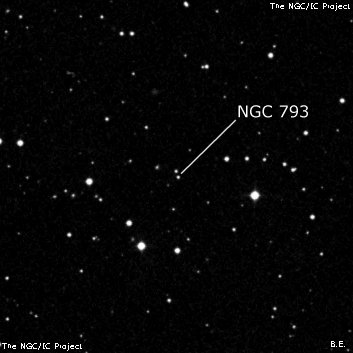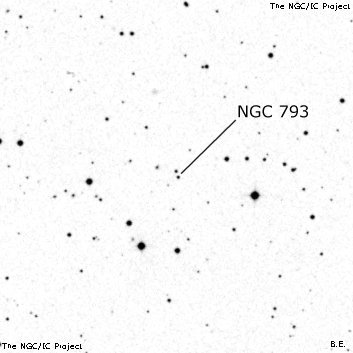NGC/IC Project Restoration Effort
(This is a very very beta version)
NGC793


Basic Information
Location and Magnitude
Right Ascension: 2:2:54.5
Declination: +31:58:53
Constellation: TRI
Visual Magnitude:
Historic Information
Discoverer: Lohse
Year of discovery: 1886
Discovery aperture: 15.5
Observational
Summary description: vvF, bet 2 st, sf 5210
Sub-type: *2
Corwin's Notes
=====
NGC 793. This is one of the few nebulae found by J.G. Lohse, an English
amateur astronomer, working at the observatory of another amateur, Mr.
Wigglesworth. Unfortunately, the observations never seem to have been
published outside the NGC, so Lohse's approximate position and description as
recorded in the NGC is all the information that we have.
For this particular object, the NGC tells us only, "Very very faint, between
two stars; south-following GC 5210 [NGC 789]." The only object in the area
that fits the description is the faint double star about two arcmin southeast
of Lohse's place. It is quite a faint object (it is not in GSC), so Mr.
Wigglesworth must have had a considerable telescope if Lohse was to have seen
it. Some digging in the literature is clearly called for to find the details
we need to know about the observatory and its instruments. Without that, my
possible identification, while fitting Lohse's description, can only be
tentative.
-----
Since I wrote that many years ago, Wolfgang Steinicke has done the historical
research to find that James Wigglesworth's observatory at Scarborough in
Yorkshire housed a 15.5-inch F15 Cooke refractor. This telescope was
certainly capable of turning out the double star that we think might be
Lohse's object, so I've changed the question mark to a colon.
Lohse, by the way, was born in Germany, though worked for much of his career
in Scotland with Ralph Copeland, as well as in Scarborough with Wigglesworth.
Wolfgang's web pages, and his book "Observing and Cataloguing Nebulae and Star
Clusters" (Cambridge, 2010), have more details for those interested.



